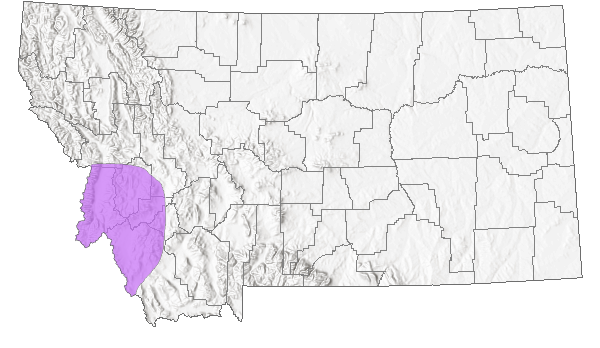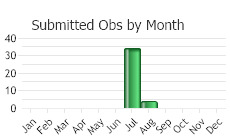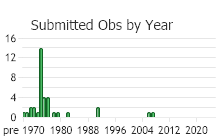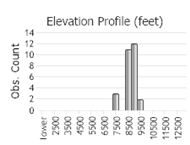View in other NatureServe Network Field Guides
NatureServe
Montana
Utah
Wyoming
Idaho
Wisconsin
British Columbia
South Carolina
Yukon
California
New York
Storm Saxifrage - Micranthes tempestiva
Other Names:
Saxifraga tempestiva
State Rank Reason (see State Rank above)
State endemic known from approximately a dozen extant sites in southwest Montana. The high elevation habitat of the species in conjuction with approximately half of the populations in designated wilderness areas minimize the potential for negative impacts to the species.
- Details on Status Ranking and Review
Population Size
Score1-2 - Small to Moderate. Population size is imprecisely known but is believed to be >2,000 individuals and <100,000 individuals.
CommentPopulation numbers are poorly documented.
Range Extent
Score3 - Local Endemic or Very Small Montana Range: Generally restricted to an area <10,000 sq. miles (equivalent to the combined area of Phillips and Valley Counties) or <6 Sub-basins (4th code watersheds) Range-wide OR limited to one Sub-basin in Montana
Area of Occupancy
Score2 - Low: Generally occurring in 4-10 Subwatersheds (6th Code HUC’s).
Environmental Specificity
Score2 - High: Species is restricted to a highly specialized and limited habitat and is typically dependent upon unaltered, high-quality habitat (C Values of 8-10).
Trends
Score0-2 - Stable to Moderate Declines:
CommentTrends are undocumented, but it appears to be unlikely that the species is experiencing significant declines. Habitat is largely intact at this time. However, warming and drying trends could be having adverse impacts.
Threats
Score0-1 - Low to Medium.
CommentNo significant or widespread threats are known at this time.
Intrinsic Vulnerability
Score1 - Moderate Vulnerability: Specific biological attributes, unusual life history characteristics or limited reproductive potential makes the species susceptible to extirpation from stochastic events or other adverse impacts to its habitat and slow to recover.
Raw Conservation Status Score
Score
9 to 13 total points scored out of a possible 19.
General Description
Storm Saxifrage is a small perennial with a basal rosette of leaves and 1 to a few naked stems that are 3-8 cm tall and arising from a simple or branched rootstock. The glabrous, mostly entire-margined leaves are 5-25 mm long and linear to egg-shaped with an indistinct petiole. The white flowers are borne in 1 to a few compact clusters at the top of the stem. The separate sepals are spreading or erect and 1-3 mm long. The 5 separate petals are approximately 1 mm long and always shorter than the sepals. Anthers are orange. The fruit is a two-lobed capsule.
Phenology
Flowering in June-July.
Diagnostic Characteristics
Saxifra rhomboidea, S. integrifolia, S. oregana and S. occidentalis are similar species that may occur in similar alpine habitats. Saxifraga tempestiva can be distinguished by the combination of its small size, more nearly linear leaves, and petals that are smaller than the sepals, rather than longer or absent.
Species Range
Montana Range
Range Descriptions

 Native
Native
Range Comments
Montana endemic; Beaverhead, Deer Lodge, Granite & Ravalli Counties, Montana.
Observations in Montana Natural Heritage Program Database
Number of Observations: 39
(Click on the following maps and charts to see full sized version)
Map Help and Descriptions
Relative Density

Recency



 (Observations spanning multiple months or years are excluded from time charts)
(Observations spanning multiple months or years are excluded from time charts)
Habitat
Vernally moist, open soil in meadows and on rock ledges in the subalpine and alpine zones.
National Vegetation Classification System Groups Associated with this Species
Alpine
Alpine - Sparse and Barren
Alpine - Vegetated
Wetland and Riparian
Alpine Riparian and Wetland
Stewardship Responsibility
Threats or Limiting Factors
STATE THREAT SCORE REASON
Threat impact not assigned because threats are not known (MTNHP Threat Assessment 2021).
References
- Literature Cited AboveLegend:
 View Online Publication
View Online Publication MTNHP Threat Assessment. 2021. State Threat Score Assignment and Assessment of Reported Threats from 2006 to 2021 for State-listed Vascular Plants. Botany Program, Montana Natural Heritage Program, Helena, Montana.
MTNHP Threat Assessment. 2021. State Threat Score Assignment and Assessment of Reported Threats from 2006 to 2021 for State-listed Vascular Plants. Botany Program, Montana Natural Heritage Program, Helena, Montana.
- Additional ReferencesLegend:
 View Online Publication
View Online Publication
Do you know of a citation we're missing? Achuff, P. L. and L. S. Roe. 1992. Botanical survey of the Goat Flat proposed Research Natural Area, Deerlodge National Forest. Unpublished report to the Deerlodge National Forest. Montana Natural Heritage Program, Helena, MT. 31 pp.
Achuff, P. L. and L. S. Roe. 1992. Botanical survey of the Goat Flat proposed Research Natural Area, Deerlodge National Forest. Unpublished report to the Deerlodge National Forest. Montana Natural Heritage Program, Helena, MT. 31 pp. Elvander, P. and M. Denton. 1976. Saxifraga Tempestiva (Saxifragaceae), A New Species From the Pnw. Madrono 23: 346
Elvander, P. and M. Denton. 1976. Saxifraga Tempestiva (Saxifragaceae), A New Species From the Pnw. Madrono 23: 346 Elvander, P.E. 1984. The taxonomy of Saxifraga (Saxifragaceae) section boraphila subsection integrifoliae in western North America. Systematic Botany Monographs 3:1-44.
Elvander, P.E. 1984. The taxonomy of Saxifraga (Saxifragaceae) section boraphila subsection integrifoliae in western North America. Systematic Botany Monographs 3:1-44. Lackschewitz, K. 1991. Vascular plants of west-central Montana--identification guidebook. U.S. Forest Service Intermountain Research Station, Ogden, UT. 648 pp.
Lackschewitz, K. 1991. Vascular plants of west-central Montana--identification guidebook. U.S. Forest Service Intermountain Research Station, Ogden, UT. 648 pp. Lesica, P. 1992. Vascular plant and sensitive plant species inventory for the Highland Mountains, Deerlodge National Forest. Unpublished report prepared for the Deerlodge National Forest. Montana Natural Heritage Program, Helena, MT. 21 pp. plus appendices, photographs.
Lesica, P. 1992. Vascular plant and sensitive plant species inventory for the Highland Mountains, Deerlodge National Forest. Unpublished report prepared for the Deerlodge National Forest. Montana Natural Heritage Program, Helena, MT. 21 pp. plus appendices, photographs. Lesica, P., M.T. Lavin, and P.F. Stickney. 2012. Manual of Montana Vascular Plants. Fort Worth, TX: BRIT Press. viii + 771 p.
Lesica, P., M.T. Lavin, and P.F. Stickney. 2012. Manual of Montana Vascular Plants. Fort Worth, TX: BRIT Press. viii + 771 p. Lesica, P., M.T. Lavin, and P.F. Stickney. 2022. Manual of Montana Vascular Plants, Second Edition. Fort Worth, TX: BRIT Press. viii + 779 p.
Lesica, P., M.T. Lavin, and P.F. Stickney. 2022. Manual of Montana Vascular Plants, Second Edition. Fort Worth, TX: BRIT Press. viii + 779 p. Schassberger, L.A. 1991. Rare plant inventory of the East Pioneer Mountains. Prepared for the USDA Forest Service, Region 1, Beaverhead National Forest. Montana Natural Heritage Program, Helena, MT. 55 pp.
Schassberger, L.A. 1991. Rare plant inventory of the East Pioneer Mountains. Prepared for the USDA Forest Service, Region 1, Beaverhead National Forest. Montana Natural Heritage Program, Helena, MT. 55 pp.
- Web Search Engines for Articles on "Storm Saxifrage"





